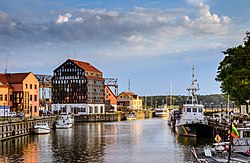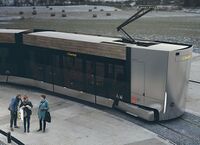Balvi
Balvi
Balowice | |
|---|---|
City | |
 Balvi's famous river | |
| Country | Hytekia |
| Municipality | Lesinia |
| Population | |
| • City | 87,615 |
| • Metro | 110,623 |
| Demonym | Balvians |
Balvi (Lesinic: Balowice [bäˈlɔvʲit͡sɛ]) is a city and historical defensive settlement in the Lesinia municipality of Hytekia, most of the city speaks Lesinic, a minority language spread between Hytekia, Tudonia and Chokashia. Settled in the mid-11th century on River Darmens, Balvi served as an important fortress in medieval times in central Alemannia, and was important in many conquests throughout that time period. With some of the city destroyed by Tudonian bombardment during the First Great War, a rebuilding effort commenced in 1904 that concluded in 1928, and the city was designated as a significant historical site due to its minority language affiliations and also due to its famous rivers and canals, which stretch throughout the city and shape its daily life.
History
The first mention of Balvi was in 1086 in a census conducted by Jan II, the Duke of Lesinia, who built it as an outpost to better defend the Duchy from invasion from the Tudonian kingdoms in the east. Balvi's location made the nearby land extremely fertile and arable, and the town initially experienced high migration rates, going from 176 people in 1086 to around 2,400 by 1100. In 1117, the first canal in the town was constructed, extended the central River Darmens, of which the town was expanding around, to a nearby farm to speed up watering and the irrigation process. The canal led to better harvests more frequently, and the town began to fiscally prosper, becoming the main source of income for the Duchy and eventually being delegated as its capital in 1145, leading to increased urban buildup in the area, culminating in the construction of its first main fortress in 1150.
The town was granted religious rights to the construction of churches and places of worship in 1161, with the Holy Church of Saint Alydian in the city's centre being built in 1164, giving the city not only geographical and defensive importance, but also holy and religious importance. The church is the largest in the Lesinia municipality and attracts thousands of visitors every month. The city incorporated the nearby village of Vieglas into its metropolitan area in 1165, which marked the first period of large expansion for the city, which by now had increased its population to around 10,000, making it one of the largest settlements in western Alemannia at the time, and the largest in the Duchy of Lesinia by a considerable margin.
The city was majorly sieged for the first time by the Ragucin Empire in 1300, during the empire's rapid expansion into most of Alemannia, the city was taken in 1301 and the Duchy of Lesinia ceased to exist after the remaining forces of the Duke were encircled and slaughtered just east of the city. Under the Ragucin, Lesinic was originally permitted to be spoken and the language survived the foreign occupation, but the town began to shrink as people began to migrate westwards towards the larger cities in the empire, mainly Krasno, after famines and rural neglect led to hundreds of deaths in Balvi. In 1337, however, Lesinic began to be widely persecuted and those caught speaking it were often killed in the street by Ragucin soldiers tasked with policing the city, as ethnic and linguistic differences from the Ragucin began to be persecuted throughout the empire. Due to Lesinic people's small population, they were severely affected by this persecution, with historians and linguists estimating that the number of fluent Lesinic speakers shrunk up to 50% by the time the Ragucin were pushed out of the city by the Aschenbach League in 1396. After which a short-lived Lesinic state existed, which made attempts to restore the language to its original numbers but ultimate were conquered by the newly established Margraviate of Ezeravira in 1449. Ezeravira chose not to persecute the language akin to the Ragucin, but speakers of the language were regularly frowned upon by the Hytek-speaking upper class (and in some cases, Alemannic-speaking), and treated as second-class citizens, often being relegated to labourious occupations like farmers or mill workers. This changed however as the Lesinic people were recognised as citizens proper of Ezeravira upon decree of Margrave Ivars IX in 1577, and their population began to flourish in the east, leading to a population boom in Balvi that raised the population to as high as 20,000 by the turn of the 17th century.
Religious literature in Balvi were extremely prevalent, but prominent thinkers began to move to Balvi due to its scenic background that many described as mind-clearing and a break from reality. Many political and religious thinkers spent time in Balvi throughout the 17th and 18th centuries, but the Margraviate began to crack down on dissidents in the town, which led to the Balvi Revolt of 1774, ending in the destruction of some of the inner portions of the old town, and the deaths of some 500 Balvi residents. After the revolt, policing began to increase on the eastern settlement, and another fortress was constructed the same year to better execute control over the city, which was becoming more dissident due to its residents and preachers in the street. The Balvi Decree of 1778 stripped the town of its autonomous rights it had enjoyed since the 1500s, referring to it as "an integral part of the Ezeraviran realm, and a formal part of the region of Hytekia". The Balvi Decree marked the official end to any sort of Lesinic autonomy in Alemannia, until the 1950s, when they were granted the Sworwall SAR in Tudonia.
The industrial revolution reached Balvi in 1831 when the first factories began to be constructed, mainly steel factories that made parts for military equipment, due to Balvi's smaller size compared to the industrialising cities of the west, the town fully industrialised quicker than its western counterparts, and the town enjoyed an extremely low unemployment rate for the time, prompting more migration into the city. The town reached a population of around 35,000 by 1840, most of whom could only speak basic Lesinic. Due to the rapid migration and population increase, the Lesinic Language School was established in Balvi in 1844, teaching its residents the Lesinic language for free if they could provide proof of employment within the town's boundaries. The Lesinic Language School's presence in the town ultimately led to its rejection of the Alemannification of Hytekia, and the residents of the city kept speaking Hytek and Lesinic, one of the few places in Hytekia to do so. When Hytekia entered a personal union over Juznia in 1860, many Juznik migrants came to the town for employment. Lesinia's place as an integral part of Hytekia was reaffirmed in the Constitution of the Kingdom of Hytekojuznia in 1884.
Balvi served as a fortress in the Great War, but a lot of the central town was damaged or destroyed by Tudonian bombardments, which continued throughout the war up until its conclusion in 1899, with Tudonia not making any attempts to advance on the city. Many Lesinics fought and died for Hytekojuznia in the war, and the population of Balvi decreased for the first time in centuries, recording a population of 36,701 in the 1901 census. Reconstruction of the town was ordered by Johannes II in 1904, which employed many Lesinics to retain stability in the region. Even after the revolution that established the People's State, the reconstruction of the city was continued by Viliks and Talbergs, and eventually concluded in 1928, where the town was given city status and designated as a significant historical site within Hytekojuznia. Balvi de-industrialised throughout the 1940s and 1950s, where it progressed towards a more tourism-based economy, similar to what it is today. Balvi's picturesque buildings, scenic rivers and vibrant history made it an attractive tourist destinations for many Alemannics and Asurans in the mid-to-late 20th century. Today it operates mainly as a tourist destination, with many of the city's residents speaking up to four languages (usually Lesinic, Hytek, Mascyllary Alemannic and Midrasian, sometimes Newreyan), and the city is well-equipped for foreign language speakers.
Geography
Balvi sits on the River Darmens, the longest river in Hytekia, the same river the country’s largest city, Krasno, is situated on. While the river is considerably narrower by the time it passes through Balvi, it is still a major water source for the city and the surrounding Lesinia Municipality. It is settled on a generally low-lying part of Hytekia, with its highest part being only ten metres above sea level, common for eastern rural Hytekia. Balvi is situated in far-eastern Hytekia, and is around halfway between Krasno and the Tudonian capital, Sigairen. Around five kilometres to the North of Balvi, there is a border crossing into Tudonia, with the centre of the Tudonian town of Łagodów being only about ten kilometre away of Balvi.
Lesinia Municipality
Balvi is the largest city in the Lesinia Municipality, which enjoys some educational autonomy from the rest of Hytekia in the mandatory teaching of the Lesinic language at school. Balvi also serves as the capital of the municipality. Balvi itself is separated into four districts, each of which are governed by the Lesinia Municipality government, situated in Balvi.
Culture
The Balvi Museum of Lesinic Art, Culture and Language is the largest museum dedicated to the Lesinic culture and language in the world, and it organises many galleries and shows to promote the culture year-round. Balvi is also the largest Lesinic-majority city in the world and in modern times is generally regarded as the home settlement of the Lesinic people.
Sport
The city has a football team, Balvi SK, which plays in the Kauss First Division, the top flight of Hytek football. Balvi SK is a mid-table team but is not overly successful in domestic football. The city's football team, however, the Balvi Knights, are successful in the Hytek First Division, the top flight of Hytek rugby union, with many of its players playing for the Hytekia national rugby union team.
Transportation
Balvi is a minor stop on the HGZ Alemannia, and the city has high speed rail both into Tudonia and towards western Hytekia. It was added to the HGZ route in 2002, and is the main way for commuters to go to and from the city. The city has a small airport to the north, but it only serves smaller planes and is mainly a hub for domestic flights, with no airport connection to the HGZ. Though there is a bus system, its main form of transportation is its trams, which cover most of the city and are modernised, having opened in 2016. Its trams are eco-friendly and emit zero carbon, being entirely electric powered, leading to some people calling Balvi one of the most eco-friendly cities in the world.








